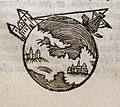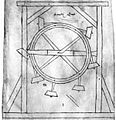Medieval diagram
Gallery of medieval diagrams. According to Friendly (2008) in the earliest forms of thematic cartography, statistical graphics, and data visualization were represented in "geometric diagrams, in tables of the positions of stars and other celestial bodies, and in the making of maps to aid in navigation and exploration.".[1]
Types of diagrams
[edit]Different types of diagrams, that emerged in Medieval times with some of the most original examples.
-
Concept map, 9th century
-
Table, ca. 1020
-
Concept map, ca. 1080
-
Graph, late 10th century
-
Solar system diagram, 12th century
-
Représentation du système géocentrique, 1120-1260
-
Tree of Jesse, 1175
-
Family tree, late 12th c.
-
Shield of the Trinity diagram, ca. 1210
-
Classification chart of knowledge, late 13th century
-
Tree diagram of knowledge, ca 1305.
-
Proto-Bar chart, 1350/1505
Themes and/or specific fields
[edit]Cosmology
[edit]-
Diagram of the Relation of Human and Cosmic Phenomena. 9th century
-
Byrthferth enchiridion, ca. 1080
-
Représentation du système géocentrique, 1120-1260
-
Diagram illustrating the relationship of the Planets to the Brain, 1159-75
Astronomy
[edit]-
Planetary Movements, 10th century
-
Star map for celestial globe, 11th century
-
Copy of De Sphaera of Sacrobosco, 1230.
-
Sphaera of Sacrobosco, 1230.
-
Part of a German "Volksbuch", 1190-1200.
-
Qutb al-Din al-Shirazi's planetary model, 1284
-
Lunar eclipse al-Biruni, 11th century
-
Optic studies by Bacon, 1260s
-
Solar system by Pedro Alfonso, 12th century
-
Diagram with Zodiac Symbols, 1335–50.
-
Volvelle Sacrobosco's De Sphaera, 16th century representation
-
1573 representation of Martianus Capella's geo-heliocentric astronomical model c. 5th c.
Geography
[edit]- See also Category:Maps made in 10th century, 11th century, 12th century, 13th century, 14th century
-
Earth from Macrobius, Commentarii in Somnium Scipionis, ca. 1150.
-
The spherical earth in a 12th century manuscript
-
1550 illustration of 13th century textbook
-
John Gower's portrait in his Vox Clamantis and Chronica, ca 1400
-
Beatus Mappa Mundi, 1050
Biology
[edit]-
Anatomy of a horse from 15th century
-
The eye according to Hunain ibn Ishaq, ca. 1200
-
Optics from Roger Bacon, late 13th c.
-
Jacob van Maerlants, Der naturen bloeme, 13th c.
Cognition
[edit]-
Head, showing cells of brain ventricles, c. 1347
-
Circles on either side of the head illustrate the four supposed ventricles of the brain, 14th c.
-
The brain, and ways of excretion of humours, c. 1428
-
The Ventricles, from 1489 to 1503
-
Diagram showing the Ventricles of the Brain, 1496
Organizational structures
[edit]-
Hortus Deliciarum, Die Philosophie mit den sieben freien Künsten, 1180
-
King Henry II England and Thomas Becket, 1307-1327
-
Round Table in the Grand Hall, Winchester, England, United-Kingdom, 1348
-
Organizational Structure of the Empire of the Holy Roman Empire in Nuremberg Chronicle, 1493
-
Tuebinger Hausbuch Freie Kuenste, 15th century
-
Double-headed eagle with coats of arms of individual states, symbol of the Holy Roman Empire, 1510
Architecture
[edit]- See also Evolution of Perspective and Technical drawing
-
Page from the Sketchbook of Villard de Honnecourt, 1230
-
Page from the Sketchbook of Villard de Honnecourt, 1230
-
Page from the Sketchbook of Villard de Honnecourt, 1230
Technical artifacts
[edit]- See also: Category:Medieval technical drawings,
-
Drawing of section of an astronomical clock, 1364
-
Perpetuum Mobile of Villard de Honnecourt (about 1230)
People
[edit]-
John Gower's portrait in his Vox Clamantis and Chronica, ca 1400
Religion
[edit]-
Earliest attested version of en:Shield of the Trinity diagram, ca 1210
-
Diagram with Crucifixion, 1335–50.
Calendars
[edit]-
Mosaic pavement of a 6th century synagogue at Beit Alpha, Israel.
-
Calendar from the Catalan Atlas of 1375 by Abraham and Jehuda Cresques.
-
Illustration form the Aurora consurgens, 15th century
Datavisualization
[edit]- see also Tree diagrams, Classification chart
-
Tree of virtues and vices, 1120
-
Tree of virtues, c. 1260
-
Arbol ciencia ramon llull, 1505.
-
Raimundus Lullus Ars Magna Tree, ca 1305.
-
Image of a human body in a pentagram, 15th century
-
Tower of Wisdom
-
Oresmes diagrams, 1505
-
Ars Magna Fig 1
-
Letter S
Geometric patterns and compositions
[edit]Geometric patterns
[edit]Geometric compositions
[edit]Illustrators
[edit]Villard de Honnecourt
[edit]- See also Category:Villard de Honnecourt
Villard de Honnecourt lived in 13th century France and may have been an itinerant master-builder of Picardy in northern France. His fame rests entirely on his surviving portfolio of 33 sheets of parchment (animal skin) containing about 250 drawings from about the 1230s, which is in the Bibliothèque Nationale, Paris (MS Fr 19093). It appears to be a model-book, with a wide range of religious and secular figures suitable for sculpture, and architectural plans, elevations and details, ecclesiastical objects and mechanical devices, with copious annotations. Other subjects such as animals and human figures also appear.
- See also
Ramon Llull
[edit]- See also Category:Ramon Llull and Category:Diagrams of Ramon Llull
Ramon Llull (1232–1315) was a Majorcan writer and philosopher. He wrote the first major work of Catalan language literature. Recently surfaced manuscripts show him to have anticipated by several centuries prominent work on elections theory. He is sometimes considered a pioneer of computation theory, especially given his influence on Gottfried Leibniz.
-
Raimundus Lullus Ars Magna Tree, ca 1305.
-
Ars Magna Fig 1
-
Ramon Llull - Ars Magna Fig 1-4
-
Ars Magna, 13th-14th century
-
Arbol ciencia ramon llull, 1505.
-
1505
-
The ladder of ascent and descent, 1512
- See also
Nicholas Oresme
[edit]- See also Category:Nicholas Oresme
Nicholas Oresme (c. 1323 - 1382) was one of the most famous and influential philosophers of the later Middle Ages. He was an economist, mathematician, physicist, astronomer, philosopher, psychologist, musicologist, theologian and Bishop of Lisieux, a competent translator, counselor of King Charles V of France, one of the principal founders and popularizers of modern sciences, and probably one of the most original thinkers of the 14th century.
-
Illustration of the Celestial spheres, 1377
-
A page from Tractatus de latitudinibus formarum, 1505
-
Oresmes diagrams, 1505



















































































